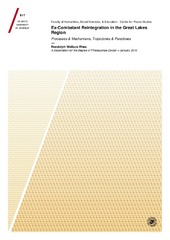Ex-Combatant Reintegration in the Great Lakes Region: Processes & Mechanisms, Trajectories & Paradoxes
Permanent link
https://hdl.handle.net/10037/9500Date
2016-05-13Type
Doctoral thesisDoktorgradsavhandling
Author
Rhea, Randolph WallaceAbstract
Since the early 1990’s, the Great Lakes Region (GLR) has been devastated by a wave of interconnected interstate, intrastate, and local conflicts involving hundreds of thousands of soldiers in dozens of armed groups. An important part of the international community’s approach to peacebuilding in the region has involved the disarmament, demobilization, and reintegration (DDR) of armed groups. Because of the transnational nature of many armed groups in the GLR, a regional approach to DDR has been adopted. The World Banks Multi-Country Reintegration Program (MDRP) and Transitional Demobilization and Reintegration Program (TDRP) have been key institutions involved in facilitating national efforts for the demobilization and reintegration of ex-combatants across the region.
While DDR has evolved considerably since 1990’s, the reintegration component remains among the cruxes. One reason for the enduring challenge of reintegration is that while technical approaches to the delivery of reintegration programming have become ever more refined, the nature of the social and economic reintegration processes that reintegration programs aim to affect in individual ex-combatants have remained largely unproblematized. The mixed track record of DDR programs in the GLR, and around the world, speaks to the idea that without a deep understanding of the endogenous social and economic processes of reintegration, reintegration programs might risk becoming detached from the outcomes they mean to affect.
Through the monitoring and evaluation (M&E) of reintegration programming in the GLR, the TDRP has collected vast amounts of social and economic survey data on ex-combatants and community members. Previously, this data has been used to evaluate the extent of reintegration programming impacts in specific country contexts. However, in 2013 the TDRP merged a series of survey datasets that include the experiences of nearly 10,000 ex-combatants and community members from across five GLR countries (Rwanda, Uganda, Burundi, DRC, and RoC) captured between 2010 and 2012. The merged TDRP-GLR Reintegration Dataset opens the door to the systematic comparative analysis of the social and economic reintegration processes that individual ex-combatants navigate across GLR.
In examining the social and economic processes through which individual ex-combatants across the GLR reintegrate, this doctoral thesis explores numerous issues. We investigate the deep set of social and economic disadvantages that ex-combatants carry with them as they attempt to reintegrate, and the ways in which disadvantages can influence the economic livelihood strategies that ex-combatants pursue as a part of reintegration. In turn, we reflect on the relationship of economic processes to a slower moving set of social processes that revolve around negotiating identity and building social networks. Further, we consider the profound role of gender in shaping individual ex-combatants’ social and economic reintegration experiences.
Based on this set of insights about some of the underlying social and economic processes that ex-combatants across the GLR navigate during reintegration, we move to reflect more broadly about the direct implications for our understanding of the potential role of reintegration programming in shaping post-conflict societies, and how we understand the successes and failures of reintegration programming through M&E.
Publisher
UiT Norges arktiske universitetUiT The Arctic University of Norway
Metadata
Show full item recordCollections
Copyright 2016 The Author(s)
The following license file are associated with this item:


 English
English norsk
norsk
